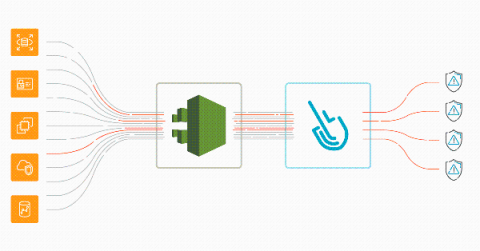Operations | Monitoring | ITSM | DevOps | Cloud
Threat Detection
AWS threat detection using CloudTrail and Sysdig Secure
Implementing AWS threat detection with Sysdig Secure takes just a few minutes. Discover how to improve the security of your cloud infrastructure using AWS CloudTrail and Sysdig Cloud Connector. With the rise of microservices and DevOps practices, a new level of dangerous actors threatens the cloud environment that governs all of your infrastructure. A malicious or inattentive cloud API request could have a sizable impact on availability, performance, and last but not least, billing.
Using Private Threat Intelligence Feeds on Hidden Security Attacks with Logz.io
Oftentimes, security attacks that were clearly recorded in logs go unnoticed. They are obscured by a large sea of log data created by most modern cloud environments. In some cases, like during a DDoS attack, there will be a huge spike in logs so it will be very clear what happened. In other situations, just a few logs will document the attack. Finding these logs can be like finding a needle in a hay stack. But if you know what to looks for, it doesn’t need to be so hard to spot these attacks.
Guard Your Business Like a Warrior with These 10 Tools
Cybersecurity has been a core issue in business management and growth. As businesses try to manage more remote teams, it’s important now more than ever. With technology becoming an integral part of our everyday lives, we’re exposed to an ever-growing risk of cyber-attacks and malicious technological crimes. According to a recent study, on average, hack attacks occur every 39 seconds. That is, one in three Americans is a victim of cybercrime every year.
Practical security engineering: Stateful detection
Detection engineering at Elastic is both a set of reliable principles — or methodologies — and a collection of effective tools. In this series, we’ll share some of the foundational concepts that we’ve discovered over time to deliver resilient detection logic. In this blog post, we will share a concept we call stateful detection and explain why it's important for detection.
4 Reasons Why IT Risk Detection is Critical in the Service Desk
Adversary tradecraft 101: Hunting for persistence using Elastic Security (Part 1)
Last month, we hosted a webinar, Hunting for persistence using Elastic Security, where we examined some techniques that attackers use in the wild to maintain presence in their victim’s environment. In this two-part blog series, we’ll share the details of what was covered during our webinar with the goal of helping security practitioners improve their visibility of these offensive persistence techniques and help to undermine the efficacy of these attacks against their organization.
Mac system extensions for threat detection: Part 3
This is the third and final post of a three-part series on understanding kernel extension frameworks for Mac systems. In part 1, we reviewed the existing kernel extension frameworks and the information that these frameworks can provide. In part 2 we covered techniques that could be used in kernel to gather even more details on system events. In this post, we will go into the new EndpointSecurity and SystemExtensions frameworks.
How Threat Intelligence Can Improve Your Security
A new cyberattack occurs roughly every 39 seconds. Each of these attacks leaves behind a variety of evidence, including IP addresses, log events and malicious files. This evidence can be incredibly valuable to security teams but only if it’s analyzed and placed in context. There is simply too much attack data from too many sources to be useful when data is in a raw format. Threat intelligence is the solution for making raw data actionable.
Mac system extensions for threat detection: Part 1
When it comes to having visibility and detecting threats on macOS, one of the best sources of information for file system events, process events, and network events is the kernel. MacOS kernel extensions provide the ability to receive data about these events in real time with great detail. This is good for providing quick visibility into detecting anomalies and identifying possible threats.








